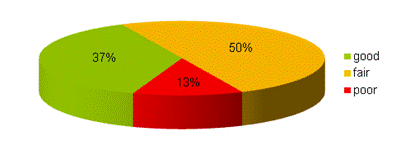Summary
In total, 35 sites were assessed in 2010 and 2012. While no sites were assessed as having excellent channel stability in 2010, three sites were in 2012. In 2010, 14 sites had good stability, 13 fair, and two sites had poor channel stability. By comparison, in 2012 three sites were graded as excellent, 14 as good, 16 sites had fair, and two had a poor channel stability.
In 2012, only two sites – Waipoua and Waipapa 2 – were assessed as having high habitat quality, indicating optimal habitat for aquatic biota.
In 2012, 46% of sites were open to livestock access. Within these, 50% of the sites were graded with a fair stability, 13% were graded with a poor stability and 37% with a good stability as illustrated in Figure 14 below.

Figure 14: Stability distribution of sites with livestock access
In 2012, 20% of sites had channel shading greater than 50% and 74% had channel shading less than 50% – six percent of the sites had a channel shading of 50%. Channel shading is an important physical characteristic for macroinvertebrate abundance as shading influences in-stream temperature and riparian vegetation provides material for in-stream habitats.
Provisional analysis of data collected over the last five years indicates that habitat quality changed at eight sites, with one site – Ngunguru – being assessed for the first time in 2012. Out of eight sites, habitat quality improved at no sites and deteriorated at four. Some of the changes observed since 2005 were inconclusive due to insufficient data and/or surveyor bias.
Out of the 20 sites available for trend analysis, stability improved at 10 and deteriorated at two. At eight sites the changes since 2005 were inconclusive s due to insufficient data and/or surveyor bias.
